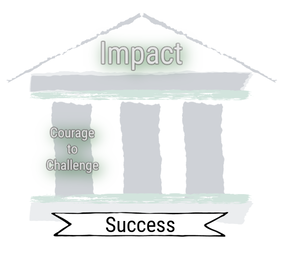Bridging Leadership Lessons from the Workplace and Those Experiences Shaping Today's Youth and Tomorrow's Leaders
 I am going to connect several key principles that I feel are critical to success and are traits that I look for in future teammates. I refer to these as Pillars of Impact as they are foundational to move from making yourself better to helping others get better as well. The first Pillar of Impact is the Courage to Challenge. The two main words in this pillar infer some type of conflict. But it doesn’t have to be a negative experience. For the Courage to Challenge to be in a positive place you need to have two ingredients:
Respectfully Challenge What you need to focus on is the question itself. How to respectfully ask a question that challenges the status quo. This is always easier when trust has been established and your credibility helps the recipient understand that you have the best intentions in mind. If not, you need to focus your questions on understanding. To learn more about the perspective, not to say they are wrong, but to increase your understanding of their perspective. In a prior post, I talked about my Mentor asking the simple question: “Is what you are saying helpful or harmful?” You have to consider how your question will be received because while your intention might be helpful, it could easily be perceived as a negative challenge and cause walls to be put in place. Creating an Environment There are many reasons why a person chooses not to challenge. Hierarchy, confidence, experience, or they don’t want to look stupid. As leaders, we need to be clear that there are no stupid questions and that everyone’s input will be respected and is encouraged. Do you promote the asking of questions in your group or do you deter the questions by always delivering answers? Do you get defensive and protective of your position? Do you feel that questions are directed towards you, the person, or the process or situation that exists? Do you interpret questions as rebellious and disruptive to the harmony of your group or do you see them as opportunities to learn and grow? Promoting critical thinking is a popular topic, but typically when you are talking about another group or people listening to your suggestions. How do you respond when critical thinking is directed towards your decision or actions? I can tell you from first-hand experience, this is really difficult. Being open to what you feel is criticism is challenging to say the least but absolutely critical if you are going to gain from the collective wisdom and experiences. Becoming a Pillar While this approach has always been part of who I am, I didn’t quite appreciate how critical it was for a team's success. I had encouraged it within my team, but I was viewing it as something I liked - almost as a personal preference - instead of as a key principle in the overall success structure. It came to a head when I attended a critical internal meeting to discuss a problem with our product with a customer. The investigation had stalled as the questionable batch, A, and a known good batch, B, had the exact same signatures. It was defying logic. When you evaluated the charts, your assumption led you to believe that either they would both have to be good, or both have to be bad. To make matters worse a third batch which looked like it should be bad, was performing well at the customer. I kept challenging the graphs and pointing out to the team that it was illogical and if A=B and B=C then A must equal C. I had frustrated everyone in the room and despite some “Master of the Obvious” comments along with some eye rolls and head grabbing, I would not let up. Finally, someone got upset enough that they pulled up the original data to “shut me up” and the person said one word…”oh.” When the presentation was made, the person incorrectly marked the graph of which batch performed well at the customer and which one did not. A simple mistake that was not challenged, propagated until it became fact. Those attending the meeting day after day, had been trained to accept it as truth as it was presented. Once the issue was identified, everything fell into place, the root cause was identified, and the problem was addressed satisfying the customer. There were a lot smarter people than me in the room. I know people had asked questions and challenged the assumptions but either they had their concerns addressed or didn’t want to ask again. Many chose not to push back because of the dynamics in the room with leadership. A fear of angering a top manager. Being viewed as disrespectful. Not wanting to risk being ridiculed if they were wrong. But I didn’t focus on why they didn’t challenge, only on how we move forward to resolve the issue. I made a statement at that point that became a mantra for Operations over the next two years: “I don’t care what you know, only what you can show.” We know the problem with assumptions. We know the problems with memory. Show me the data, validate your actions. We supported that mantra with “Peel the Onion” encouraging people to dig deeper. The discussion with my team was a lot more direct. I stressed that if they could not challenge, then they couldn’t lead and they needed to decide if they wanted to lead or not. I already knew the answer when I asked it and boy did they lead! The environment in that meeting was not conducive to challenging - so I had to force a change in that environment. By not backing down, I was taking the position that it was okay to challenge and that we must challenge. Breaking out of groupthink is critical to move people and organizations forward. Stagnation is not planned but a result of inaction and the Courage to Challenge the status quo is what moves you Beyond Today.
0 Comments
Leave a Reply. |
AuthorTom Brown - a husband and a father who is simply trying to make a difference. Using my experience as a Manufacturing Executive to connect leadership from the boardroom to the hardwood to help teams grow and develop to make a difference in the lives of others. Archives
May 2024
Categories |
Proudly powered by Weebly

 RSS Feed
RSS Feed

